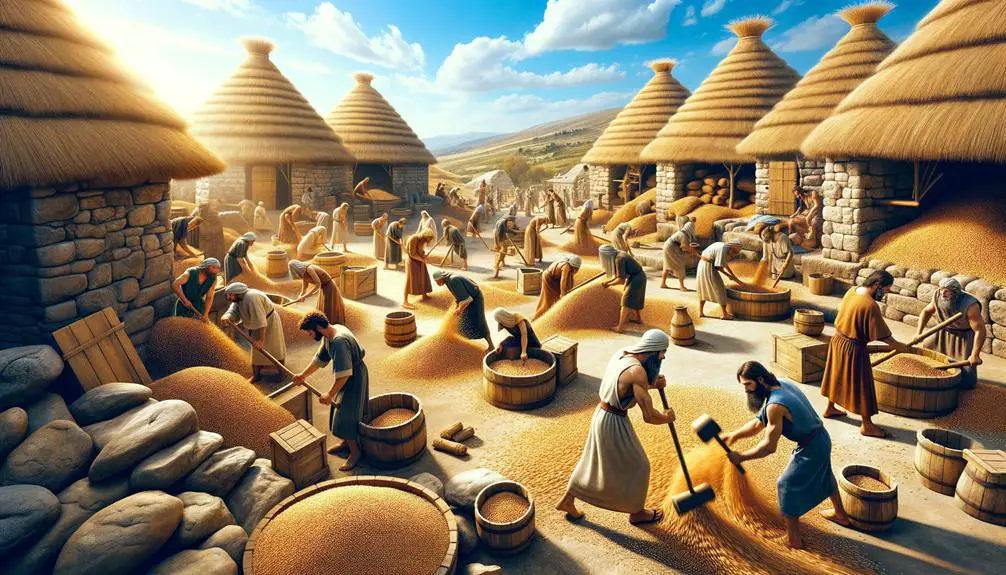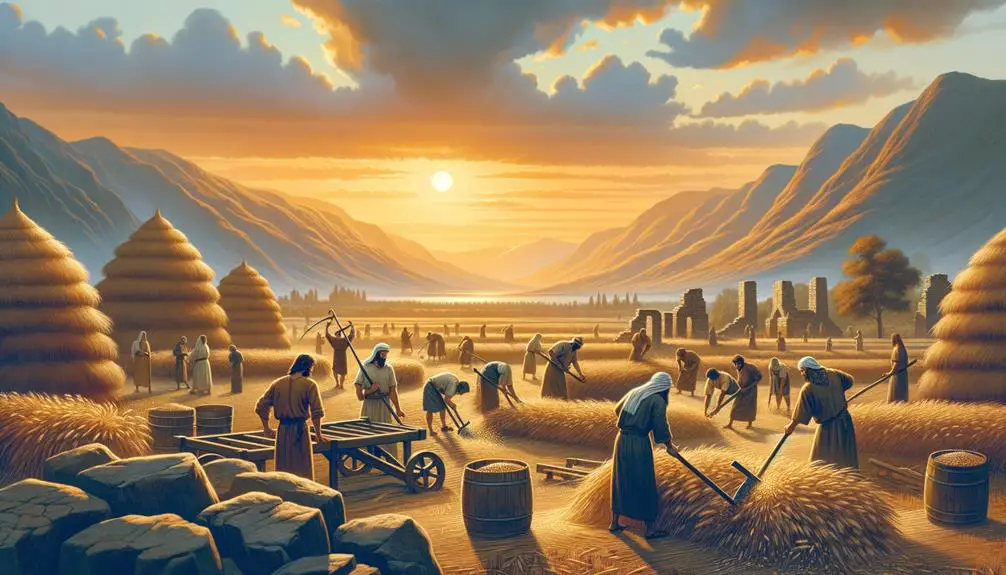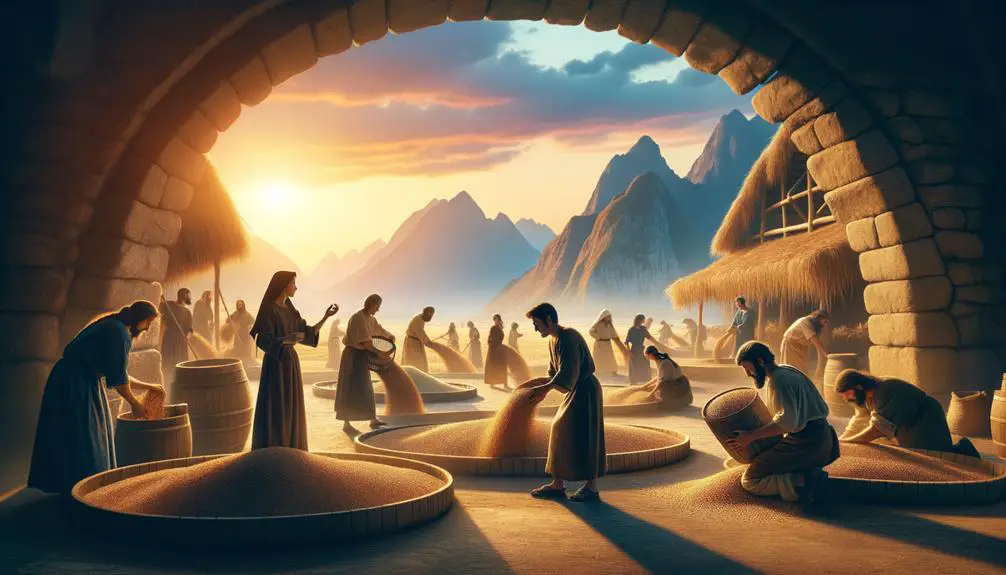Kneel at the biblical threshing floor, where grains of divine wisdom and human history are separated, inviting deeper exploration.

What Is the Threshing Floor in the Bible
Like a treasure map that leads to forgotten riches, the concept of the threshing floor in the Bible holds layers of meaning waiting to be uncovered.
You'll find it's not just a physical location where grain is separated from chaff, but a symbolic stage for pivotal biblical events and teachings.
From historical context and cultural significance to theological implications and modern interpretations, the threshing floor serves as a backdrop for divine judgment, blessings, and human interactions with the divine.
Unraveling its depths could illuminate aspects of faith, tradition, and interpretation that you've never considered before, inviting you on a journey to uncover its multifaceted significance.
Key Takeaways
- Threshing floors symbolize divine presence and serve as sites for significant biblical encounters and revelations.
- They embody spiritual significance, representing judgment, purification, and the separation of sin.
- Threshing floors played pivotal roles in economic and cultural activities within ancient communities.
- Archaeological and theological studies enhance understanding of their multifaceted significance in biblical narratives.
Historical Context

To understand the significance of the threshing floor in biblical times, it's crucial to delve into its historical context. The threshing floor, an essential component of ancient agriculture, was a flat area where farmers separated grain from chaff. This process, a cornerstone of agricultural techniques, was pivotal for societies reliant on grain as a staple food source.
You'll find that the construction of these floors was a testament to the ingenuity of ancient peoples. Typically, they were made from hard, level surfaces, often of bedrock or compacted earth, to withstand the rigors of threshing activities. The choice of construction materials was no trivial matter. It reflected an intimate knowledge of local resources and an acute understanding of their utility in creating durable and efficient threshing floors.
Moreover, these floors were strategically located to take advantage of natural elements, such as wind, which aided in the winnowing process. This method, wherein the grain was thrown into the air to allow the wind to blow away the lighter chaff, leaving the heavier grain to fall back onto the floor, underscored the sophistication of agricultural techniques of the time.
Symbolic Meanings
In the biblical narrative, threshing floors embody multifaceted symbolic meanings that intertwine with spiritual themes.
You'll find that these sites represent judgment and purification, illustrating how individuals are separated from their sins.
Additionally, they symbolize harvest and prosperity, alongside divine presence and actions, reflecting God's involvement in the cycles of judgment and blessing.
Judgment and Purification
The symbolic meanings of threshing floors in the Bible often encompass themes of judgment and purification, reflecting a deep spiritual significance within these narratives.
These spaces aren't just physical locations for separating wheat from chaff but also serve as metaphors for divine scrutiny and the separation of good from evil.
Through ritual practices performed on these grounds, the Bible presents a clear moral dichotomy, portraying the threshing floor as a site where purity is distinguished from impurity.
This dichotomous nature underscores a process not only of physical cleansing but of spiritual refinement as well.
As such, the threshing floor becomes a powerful symbol for the transformation and redemption that follows divine judgment, highlighting the path toward spiritual renewal and purity.
Harvest and Prosperity
While the threshing floor symbolizes judgment and purification, it also represents abundance and prosperity, marking the culmination of the harvest season. This duality underscores its significance in agrarian societies, where grain storage post-harvest was crucial for survival.
The process of separating wheat from chaff on the threshing floor isn't merely a physical activity but a deeply symbolic act, embodying the transition from scarcity to abundance. Seasonal rituals performed on the threshing floor further highlight this transition, embedding it within the community's cultural and religious practices.
These rituals, rich in symbolism, celebrated the successful harvest and the community's hopeful anticipation of continued prosperity. Thus, the threshing floor emerges as a multifaceted symbol, intertwining themes of judgment, purification, and the promise of abundance.
Divine Presence and Actions
Beyond its role in agriculture, the threshing floor serves as a poignant symbol of divine presence and intervention within biblical narratives. This space transcends its practical use, embodying a realm where the divine interacts with the human. Through the lens of sacred spaces and ritual practices, one can discern multiple layers of meaning associated with the threshing floor:
- A Meeting Place: It becomes a ground where heaven touches earth, facilitating divine-human encounters.
- Purification: Symbolizes the separation of wheat from chaff, mirroring the divine judgment and purification process.
- Blessings and Curses: A stage for invoking divine blessings for obedience and curses for disobedience, highlighting its role in covenantal contexts.
- Prophecy and Revelation: Often a site for prophetic visions and revelations, underscoring its significance in divine communication.
This multifaceted symbol enriches the biblical tapestry, intertwining sacred spaces with profound ritual practices.
Key Biblical Incidents
Several key biblical incidents prominently feature threshing floors, offering insights into their cultural and religious significance during ancient times. The story of Gideon's calling and Boaz's generosity, in particular, highlight the threshing floor as a space not just for agricultural activity but also for divine encounters and pivotal life events.
In the account of Gideon's calling (Judges 6:11-24), you find Gideon threshing wheat in a winepress to hide it from the Midianites. This act of threshing in secrecy, rather than at the communal threshing floor, sets the stage for a profound personal encounter with the angel of the Lord. The threshing floor here becomes a metaphorical backdrop against which themes of fear, survival, and divine calling are explored. Gideon's eventual emergence as a leader who'd deliver Israel begins in this unlikely setting, underscoring the threshing floor's role in transformation and divine revelation.
Similarly, the narrative of Boaz's generosity (Ruth 2:1-23; 4:1-12) unfolds at a threshing floor, showcasing it as a place of provision, protection, and promise. Boaz's actions towards Ruth on the threshing floor embody the values of kindness, responsibility, and communal solidarity. The threshing floor here isn't just a physical space for processing grain but also a social and relational arena where virtues are demonstrated and future blessings are secured.
These incidents, among others, illustrate the multifaceted significance of threshing floors in biblical narratives. They were more than mere sites for agricultural chores; they were venues for divine encounters, societal interactions, and critical moments that shaped individual destinies and collective histories.
Cultural Significance

CURRENT SUBTOPIC: 'Cultural Significance'
To understand the cultural significance of threshing floors in ancient times, it's essential to examine their role not only in agricultural practices but also in social and religious contexts. Threshing floors served as pivotal elements within the community, highlighting their multifaceted importance beyond mere locations for processing grain.
- Center for Agricultural Practices:
Threshing floors were fundamental in ancient agricultural systems. Here, workers separated grain from chaff, a process crucial for food preparation and storage. This activity underscored the threshing floor's role in sustaining the community's food supply.
- Venue for Social Gatherings:
Beyond their agricultural utility, threshing floors functioned as gathering spots. People convened here not only to work but to socialize, exchange news, and strengthen community bonds. These gatherings were integral in fostering a sense of unity and shared purpose among inhabitants.
- Economic Hub:
The threshing floor was also a place of trade and economic activity. Farmers traded surplus grain for other goods and services, making it a bustling marketplace that facilitated economic interactions and supported the local economy.
- Cultural Significance:
The cultural landscape of ancient communities was significantly shaped by the activities surrounding threshing floors. These sites were scenes of celebrations, rituals, and communal decisions, embedding them deeply into the social fabric and cultural identity of the people.
Analyzing the cultural significance of threshing floors reveals their role as not just agricultural sites but as vital components of social structure and community life. Their importance extended well beyond the processing of grain, illustrating their central place in ancient societies.
Theological Implications
Threshing floors in biblical times held profound theological implications, serving as stages where divine judgment and blessings were symbolically enacted. These places weren't just about the physical act of separating wheat from chaff but also deeply intertwined with ritual practices reflecting broader themes of purity, community, and divine intervention. As you delve into the narratives, it becomes clear how these physical spaces mirrored moral teachings, emphasizing the importance of righteousness and the consequences of sin.
In the process of threshing, the separation of grain from husk can be seen as an allegory for divine judgment, distinguishing between the righteous and the wicked. This process, therefore, wasn't merely agricultural but laden with spiritual significance. You might interpret these actions as a manifestation of God's will, where the threshing floor becomes a ground for testing faith and obedience.
Furthermore, these spaces were often the setting for pivotal biblical events that underscored God's direct involvement in human affairs. Through these narratives, it's evident how ritual practices at the threshing floor encapsulated lessons on humility, dedication, and repentance. The underlying message was clear: adherence to divine commands and moral teachings was paramount.
Modern Interpretations

In contemporary discourse, interpretations of biblical threshing floors have evolved, reflecting a nuanced understanding of their symbolic and theological dimensions. Scholars and theologians have delved into this topic, drawing on archaeological evidence and ethnographic parallels to shed light on how these ancient spaces were more than just physical locations for agricultural processes. They symbolized divine judgment, fertility, and community cohesion in the ancient Near Eastern context.
To paint a picture for you, consider these four key insights:
- Archaeological Evidence: Excavations have uncovered remains of ancient threshing floors, providing tangible proof of their existence and offering clues about their construction, use, and the rituals performed there. This evidence supports interpretations of the threshing floor as a multifaceted space within ancient societies.
- Ethnographic Parallels: Studies of contemporary societies with similar agricultural practices have helped scholars understand how threshing floors functioned not only for separating grain but also as communal gathering spots, often associated with significant social and religious events.
- Symbolic Interpretations: Modern theologians explore the threshing floor as a metaphor for divine judgment and purification, drawing on biblical passages where these themes are prominent. This interpretation enriches the understanding of certain biblical narratives and parables.
- Theological Dimensions: The threshing floor is seen as a space where human and divine realms intersect. This perspective emphasizes the theological significance of these sites, suggesting they were perceived as sacred spaces where God's presence could be experienced.
These insights demonstrate the depth and complexity of modern interpretations of biblical threshing floors, highlighting their importance in understanding the cultural and religious life of ancient communities.
Frequently Asked Questions
How Did the Design and Construction of Threshing Floors Evolve Over Time in Biblical Lands?
As you explore the evolution of threshing floors, you'll notice changes in floor location and material choice over time.
Initially, they were outdoors, strategically placed to catch the wind for winnowing. Later, to enhance durability and efficiency, materials shifted from natural earth to more enduring substances like stone or wood.
This evolution reflects a deep understanding of agricultural practices, optimizing the process of separating grain from chaff throughout various periods in biblical lands.
What Specific Tools or Techniques Were Used for Threshing on These Floors During Biblical Times?
In biblical times, threshing floors were where grain storage met seasonal rituals, a place buzzing like a beehive with activity.
Here, workers used tools such as flails, a long, free-swinging stick, and winnowing forks to separate grain from chaff. They employed techniques like beating the grain or tossing it into the air for the wind to blow away the lighter chaff, ensuring only the purest grain was collected for storage.
Can You Provide Examples of How Threshing Floors Are Mentioned or Used in Non-Biblical Ancient Texts or Cultures Contemporaneous With Biblical Events?
In exploring ancient texts beyond the Bible, you'll find threshing floors in Mesopotamian rituals and Greek myths, serving as pivotal cultural and religious symbols. These references highlight their significance in societal practices and beliefs, showcasing their role beyond agricultural utility.
Mesopotamian texts often depict them in ceremonial contexts, while Greek mythology integrates them into narratives, illustrating how these spaces transcended mere grain processing to embody deeper cultural meanings.
How Have Archaeological Discoveries Related to Threshing Floors Impacted Our Understanding of Ancient Agricultural Practices?
Archaeological discoveries, including ceramic analysis and soil composition studies, have significantly enriched your understanding of ancient agricultural practices.
Through these findings, you've learned how communities selected threshing floor locations, optimized for wind exposure and soil type, to maximize grain separation efficiency.
These insights have allowed you to appreciate the sophistication of ancient agricultural techniques and the critical role threshing floors played in early societies' economies and daily lives.
In What Ways Have Modern Threshing Methods and Technologies Diverged From Those Described in the Bible, and What Has Been the Impact on Agricultural Communities?
Modern threshing methods and technologies have drastically diverged from biblical times, largely due to advances in modern biotechnology and the impacts of global trade.
You're seeing a shift towards mechanization and genetic modification, which has significantly increased efficiency and yield.
However, this evolution has also led to challenges for traditional agricultural communities, including economic pressures and the need for adaptation to new technologies and market demands.
Conclusion
In conclusion, the threshing floor in the Bible serves not only as a historical site for grain processing but also embodies profound symbolic and theological meanings.
One captivating statistic reveals that ancient Israelites spent approximately one-quarter of their agricultural labor on threshing and winnowing activities, underscoring the threshing floor's centrality to their livelihood and spiritual life.
Through examining its cultural significance and modern interpretations, it's clear the threshing floor continues to offer rich insights into Biblical narratives and the ancient world's complexity.



Sign up